
Tag Archives: restaurants
Chicago Road Trip
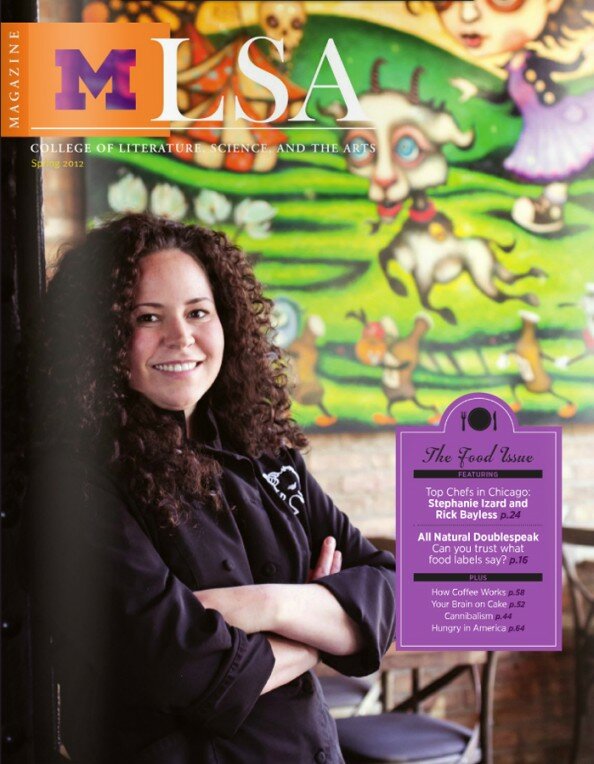 In spring 2012, my alma mater, the College of Literature, Science, and the Arts (LSA) at the University of Michigan, printed two pieces I wrote after interviewing Chicago chefs and U-M alumni Rick Bayless and Stephanie Izard. They’re both being re-published here with permission of LSA Magazine.
In spring 2012, my alma mater, the College of Literature, Science, and the Arts (LSA) at the University of Michigan, printed two pieces I wrote after interviewing Chicago chefs and U-M alumni Rick Bayless and Stephanie Izard. They’re both being re-published here with permission of LSA Magazine.
If you have but one day in Chicago this summer, I can think of no finer way to spend it than lunching at Bayless’ XOCO and having dinner at Izard’s Girl and the Goat.
* * * * *
After graduating from the College of LSA, chef Rick Bayless spent years in Mexico studying the language, the people, the food. The knowledge he brought back to the United States helped change the landscape of cuisine as we know it. The linguistics major-turned-culinary-giant gave us a seat at the table to discuss his salad days – then and now.
Chef Rick Bayless (’75, M.A.) is every bit as infatuated with Mexican cuisine today as he was in 1987 when he opened Frontera Grill in Chicago and released his first book, Authentic Mexican: Regional Cooking from the Heart of Mexico. “I can look at something I discovered 30 years ago and understand it now in such an intimate way that I could never have done at the very beginning,” he says. “That sense of deepening discovery is what keeps me going every day.”
A recent winner of Bravo’s television program Top Chef: Masters and an unquestioned legend of Chicago’s now vibrant food scene, Bayless is as big a celebrity chef as anyone in the United States. It’s hard to imagine North Clark Street without his trio of restaurants or store shelves without his salsas, but he didn’t begin his career looking to be famous. Or even to cook.
“I was really interested in the relationship between language and culture,” he says of his college years spent studying Spanish and Latin American culture. After living in Mexico with his family as a teenager, Bayless became an undergraduate at the University of Oklahoma. He spent two summers in an applied linguistics program and learned how to enter communities that lacked a written language, learn and interpret their spoken words, and ultimately understand that culture through their stories.
He followed the program’s director to LSA’s Department of Linguistics, where he began several years of doctoral work. But he found more than just scholarly interests awaiting him in Ann Arbor.
“I fell in with this group of students… we didn’t have any money at all, but we were all super into food,” Bayless recalls. “I didn’t even understand how unique the food community of Ann Arbor was then, but it was centered around the farmers’ market.” He and his friends would buy their fresh ingredients in Kerrytown and at Eastern Market in Detroit, meeting and interacting with farmers, a practice reminiscent of the everyday life he’d experienced in Mexico.
These linguistics students prepared food together regularly, exploring different cuisines from a myriad of cultures. Bayless started catering. He taught local cooking classes. Then he had an epiphany: “I was at least as interested in the relationship between culture and food as I was culture and language.”
That’s when the future James Beard National Chef of the Year stopped work on his dissertation and immersed himself in the food of Mexico.
Throughout the early 1980s, Bayless lived and traveled in Mexico with his wife, Deann Bayless (’71, ’78 M.U.S.), utilizing his academic experience to construct Authentic Mexican. Each recipe was studied using the same research methodology he learned at Michigan: He prepared each dish with three different families or cooks to grasp every nuance, every approach, every ingredient. The result was more than a cookbook; it became a comprehensive look at the cuisine of Mexico as an expression of regional culture as well as an influential guide to a burgeoning American food scene that was slowly awakening from a decade or two of hibernation.
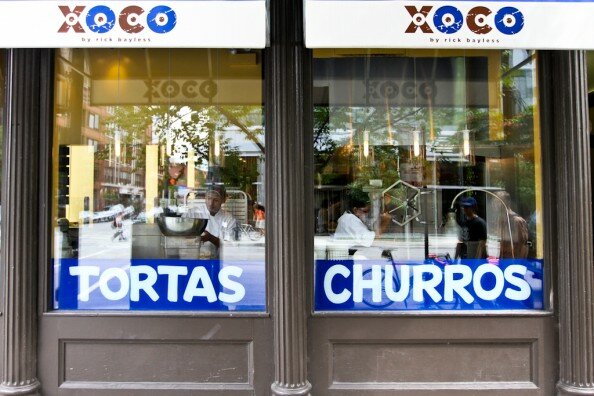
Upon returning to the United States, Bayless found himself in the midst of a dormant food culture dominated by commoditized products and corporate wholesalers – a stark contrast to his childhood.
“I’m a child of the ’60s. I made my first compost pile when I was 16. I made salt-rising bread,” he recalls. “I went with my father to the market in Oklahoma City… and the farmers would bring their stuff and we’d buy from the farmers,” Bayless remembers. “And then, that all went away and it just went to a commercial commodity market. We never had face-to-face contact with the people who were growing our food anymore. And I had a sense of loss about that.”
A do-it-yourselfer raised in a family of restaurateurs living amongst small farmers in Oklahoma, he couldn’t abide the lack of local food he found as he began his culinary career.
So Bayless set out to do things differently. He describes his first experience as a chef engaging Chicago-area farmers: “One of the things I wanted to do was put something local on our menu…. We opened in March, and May is when we have our short, local strawberry season… so I went down to the commercial market…. And they all said, ‘No one would carry those. They’re terrible.’ Well, they’re terrible only if you’re thinking of them as a commodity. They’re phenomenal if you’re thinking of them as flavor.”
Literally laughed out of the market by wholesalers, Rick and Deann drove twice per week to farmer stands outside the city to acquire those local berries for desserts. Beyond the superior flavor, the chef regained a connection to farmers in a way he hadn’t experienced since childhood. And he became increasingly grateful for it.
When Bayless talks about food, he looks and sounds as much like a professor of art history as he does a master of the culinary arts. His conference room at Frontera doubles as a library, its 10-foot walls lined with volumes on every conceivable culinary topic, ranging from French sauces to chocolate to Mexican culture to gardening. And, indeed, he broaches the subject of food as any intellectual might – that is, from every conceivable angle: flavor, art, community engagement, eco-friendliness.
Thus it’s perhaps unsurprising that his consistently calm demeanor elevates to a passionate tone when discussing the interrelated nature of his customers, his farmers, and his food.
“I have always seen restaurants – and I guess it’s because I grew up in a family-style restaurant—as creating community,” he says in describing his family’s approach to business. Along with those childhood trips meeting farmers, the notion of community has shaped his work.
“I’m an accidental organic farming champion,” he notes. “What I learned was that the people that cared most about what they were growing also cared most about the earth…. [Farmers] taught me about the interconnectedness of what I do as a living.” His holistic view of soil’s role in the food he serves his customers has led him to value sustainability. “If it’s local and sustainable, it’s part of that sense of community. It’s not just in putting money in the pocket of the farmer, but it’s protecting our environment that allows us all to thrive.”
Committed past the point of mere rhetoric or marketing, Bayless has maintained a laser-like focus: 25 years since he first ferreted out local strawberries, he has continued to push the boundaries of how local, sustainable food can be used. “The thing about food is that the more you’re around it, the deeper you can go,” he says.
During the late summer, 100 percent of his tomatoes and tomatillos are Chicago-raised. Even Tortas Frontera, his O’Hare Airport-based eatery, lists from where the food is sourced. His Frontera Farmer Foundation raised $180,000 last summer in support of local farms, and he’s a board member at the local Green City Market, the lone Chicago-area market dedicated solely to local, sustainable foods.
“With the strength of our local agricultural system, our food is different, and it allows a uniquely Chicago perspective on traditional Mexican flavor,” he says. So he strives to employ it often, noting that what he serves isn’t always what one might find in Oaxaca or the Yucatan. Rather, he asks himself, “How do you get local flavor on the plate without messing with the traditional soul that you find in Mexican kitchens?”
Bayless grows some of those Mexican-inspired ingredients on Frontera’s eco-friendly rooftop garden and at his own home. The only common ingredient that doesn’t occasionally come from Chicago-area farmers is dried chiles because, as he says, “the flavors just can’t be duplicated, and… we’re into making delicious food.”
In contrast to the many celebrity chefs leaving their hometowns, opening restaurants in Vegas or eating strange foods on cable television for shock value, Bayless’ three primary restaurants and offices are on a single block, and he’s entering the eighth season of Mexico – One Plate at a Time, airing locally in Chicago or on various PBS stations and often costarring his daughter.
When he does leave Chicago, it’s usually to visit other countries to study new cuisine and other cultures, and to enhance the culinary creativity on display at his restaurants.
“You can learn things that reflect back into your food, other techniques, and other ingredients that will open your mind to different flavor possibilities,” he observes. “Anything is open to us as long as it has the spirit of the Mexican kitchen.”
* * * * *
Chef Stephanie Izard has won Top Chef, not to mention a host of awards for her new Chicago restaurant, Girl and the Goat, but her food is neither haughty nor highbrow. Izard studies “common food” and elevates it, with a culinary result that’s like Izard herself – genuine and clever.
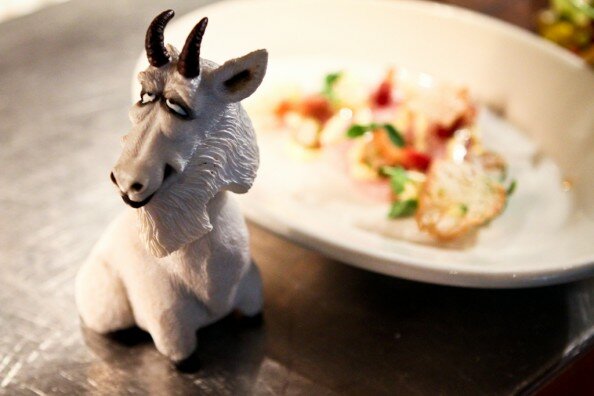
Soaked in syrupy lemon dressing, Chef Stephanie Izard’s eggplant is an eyeopening revelation. Eye-opening because it is a dessert; a revelation because it is the perfect acidic counterpoint to other elements on my plate: pork-fat doughnuts, ham streusel, caramelized figs, and a honey yogurt. Soft, crunchy, fatty, sweet, salty, and tart – it is an embodiment of Izard’s “make your whole mouth happy” philosophy.
The meals she prepares under that banner have garnered her and Girl and the Goat – the Chicago restaurant she opened in 2010 – national acclaim. Izard was a celebrity already, having won season four of Bravo’s wildly popular Top Chef, but it’s her work since, as chef and co-owner at the Goat, that have catapulted her to true stardom. Capturing rave reviews from the Chicago Tribune and Saveur magazine as well as a prestigious James Beard nomination, she was named a Food and Wine Best New Chef in 2011.
“If you could see me when I was on stage getting my award for that in New York, I had a gigantic perma-grin the entire time,” she recalls.
That’s hardly surprising: Izard’s a veritable ball of energy, talking fast, laughing a lot, and infusing every inch of her sizeable restaurant with every ounce of her sizeable persona. “I just wanted to take what I love about dining – which is hanging out with friends, usually quite a few drinks—and that’s why this place has a party vibe. Big fun with lots of energy.”
The space fosters that attitude with ample seating and high ceilings that echo with hundreds of voices, and a soundtrack that ranges from Johnny Cash to the Red Hot Chili Peppers to Regina Spektor. The bar is packed with tourists and regulars alike, and the atmosphere spawns conversation from the moment the front door opens.
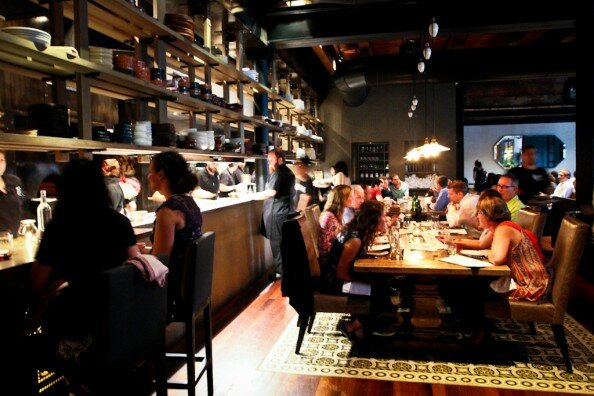
Seated at the far end of that very bar, I was quickly befriended by a 40-something professional Chicagoan awaiting some friends. Within 45 minutes, I was sharing my cauliflower with pickled peppers and mint – portions at Girl and the Goat are naturally designed for sharing with friends both old and new – and she was sharing her goat chorizo flatbread.
The shareable, approachable food is just as driven by Izard’s demeanor as the palpable friendliness imbued throughout the dining room. Signature dishes like roasted pig face, a dramatically more interesting variation on traditional head cheese, elevate comfort food and ostensibly simple ingredients to haute cuisine, without even a hint of the snobbery that sometimes pervades the restaurant world.
“I’ve been lucky and have eaten at some amazing restaurants,” says Izard, “and I enjoy it, but I don’t enjoy the stuffiness of it.I just don’t think one has to come hand in hand with the other.” She adds, “I’ve definitely always been anti-pretense.”
That attitude is exemplified in her thorough, hands-on approach. Izard doesn’t just prepare a meal; she studies each component of it. Before opening the Goat, she took the time to visit local farms, getting to know the farmers and learning everything from how the animals are treated to how goat cheese is made. “Now [the farmers are] my friends. I call them up, we hang out,” she says. Izard contracts with farms “where we liked the farmers themselves and respect what they’re doing. We only get animals from farms where we know they’re raised properly.”
Her commitment to that depth of understanding extends to every aspect of the restaurant, which includes having an inhouse baker and butcher. She’s explored an interest in beer (the lone piece of art in the restaurant features a girl, a goat, and dancing beer bottles) by visiting Indiana’s Three Floyds Brewing and by actually making beer with Chicago-based Goose Island. “I’ve gotten to brew beer a couple times. I don’t think it’s anything I could do by myself, but it’s really cool to know more about it. And we make our own wine in Walla Walla (Washington). We make our own cheese. I just kind of want to learn how to do everything.”
Izard’s curiosity about food began early at her childhood home in Connecticut, where her parents enjoyed a wide range of cuisine. She earned a sociology degree from LSA in 1998, and if there were any hint at her future, it lay in evenings out with friends.”We would go through and order all these different beers, and I remember [learning] about it and thinking, “this is cool.'”
After graduation, she enrolled in Le Cordon Bleu in Arizona, where she learned the skills that later took her to several acclaimed Chicago establishments before opening her first restaurant, Scylla, in 2006. Despite rave reviews, she opted to close in 2008, not long after which she joined Top Chef. The prize money helped pave the way to her current endeavor.
 From day one, Izard has insisted on staff sharing her excitement for their ingredients, drinks, and food.
From day one, Izard has insisted on staff sharing her excitement for their ingredients, drinks, and food.
“We interviewed over 1,000 people,” she says, “and we’ve interviewed people who worked at some of the best restaurants in the city, and I’m like ‘yeah, you’re a great server, but still, you’re not getting it. You need to have the enthusiasm, and you need to want to make someone feel comfortable as soon as they walk in the door.'”
Izard’s a master at lending that sense of comfort to her patrons: Sitting at the bar, looking toward the kitchen, I could see fans approaching her to say hi or take pictures, which often end up on the restaurant’s website. She’s become widely known for being one of the most sociable “celebrity chefs” in the country, someone who hasn’t changed as a result of her fame.”Even if I’m sick at the store and a fan comes up, I’m still going to talk to them. [Some chefs] get annoyed by people… but someone coming up to you and saying they love you? I mean, that’s pretty nice. Be happy about it.”
That connection with her devotees achieved new heights last summer when Izard launched a fundraiser for Share Our Strength, an organization fighting childhood hunger: “We’re doing these benefit dinners called Supper at Steph’s where I invite eight strangers into my house and cook dinner for them, and my staff said, ‘Seriously, Stephanie, what if they look through your underwear drawer?’ And I’m like, well, they’ll look through my underwear drawer. I don’t care.”
She’s laughing as a cook brings her a spoon covered in ginger dressing destined for the crunchy raw kohlrabi salad. “As long as I’m not in the bathroom, they’re supposed to bring me a taste.”
Izard’s well-known for carrying her upbeat persona and positive demeanor into the kitchen, a place notorious for hot tempers and demeaning attitudes. “I think that my cooks genuinely enjoy coming to work. Of course, they’re often hungover and tired and don’t really want to get here in the morning. But we have fun. We sing and dance all day. Having someone yell at me doesn’t make me want to work harder for them, it makes me want to have them not be around anymore.”
That’s not idle talk. The restaurant’s open kitchen allows patrons to peer inside. “You can see all the cooks smiling and enjoying each other’s company, which I just think is so important. If you’re putting out food that’s supposed to have all this love in it and you’re pissed off, it’s probably not going to taste as good.”
Her cooks must have an awful lot of love, because the lengthy menu is delicious from top to bottom. In her inimitable style, she doesn’t overthink it. “If I try too hard to make new menu items – like, all right, I must make a new fish dish this week, then it never works. So for me, it’s waiting to see if something just hits and something clicks. Like if I walk in the cooler and see some vegetable next to another one, and I’m like, ‘Yeah!'” That revelation explains her cross-cultural influences – for example, Izard’s crudo, an Italian-inspired raw fish dish, puts buttery Pacific hiramasa under bits of pork belly, Peruvian chiles, and caperberries.
That culinary creativity is showcased in Girl in the Kitchen, a book of recipes from her home kitchen released last October. She toured all winter to support the cookbook, while simultaneously planning her version of a classic diner, which she’s calling The Little Goat. She’s constantly busy, but she admits that’s how she likes it. “I’ve always been really driven and want to be as successful as possible. And I’m hoping to retire in 10 years, so I’ve got a lot to do.”
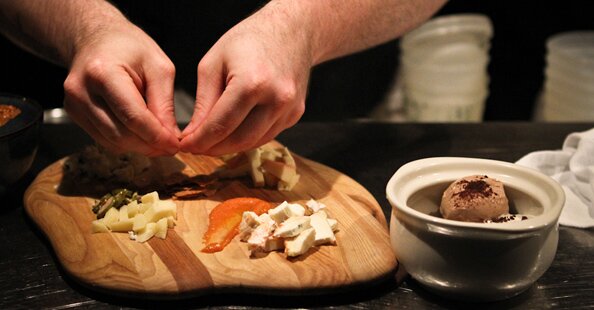
New Wine at Slows
Editor’s note: We appropriated this communication on the subject of new wine at Slows from local wine authority, Putnam Weekley. It was originally intended solely to educate the staff but we thought there was so much excellent general information on wine in these few paragraphs that it had to be shared.
Here are three new wines on our list, and I seriously adore all of them. So give credit to Tara for gettin’ em, and blame goes to me if you manage somehow to find fault with them. Item by item:
2010 Rioja, Rayos Uva. $9 / $36
Short version: this is our closest thing to the common notion of “Merlot.” Dark. Ripe, assertive fruit tannins. In terms of suggested fruits and spices, it is more linear than exotic. Considering the alternatives – at Slows now - this wine will also be the nearest thing to the common notion of “Pinot Noir.” (It’s like a Bugey Pinot with more density.) But please note, comparisons to warm weather Pinot Noir grown in fertile soils (i.e. from Santa Barbara, Willamette, and Marlborough) are much harder to make. This wine is not fat or pumped up with flavors of Jäger, bruised strawberries and cola.
The comparisons to Merlot and Pinot Noir are conveniently suggested by the biography of the winegrower. Olivier Rivière studied enology in the heartland of Merlot (Montagne St. Emilion, Bordeaux) and later worked at the great Burgundy estate of Domaine Leroy, famous for its biodynamic Pinot Noir vines.
Rayos Uva is 100% Tempranillo farmed organically and aged in large vats. It can be considered a Tinto, bottled younger than Crianza, Reserva or Gran Reserva. Oftentimes Rioja – particularly common Reserva – is associated with barrel-aged wines which can taste rather more of leather, vanillin, and tobacco. In this case by contrast, vat aging results in a wine more reminiscent of fresh fruit, ripe skins, and scented of minerals.
read more
2010 Montepulciano d’Abruzzo, La Quercia – $7 / $28
Look in any wine shop, or any list at an Italian restaurant. There are a LOT of wines bearing the appellation “Montepulciano d’Abruzzo.” (mōn-tā-pool-CHYA-nō : da-BROOTS-ō) In a crowded field of red wines competing for fickle consumer attention, common entries often exhibit signs of a winemaking arms race. There is ever more extraction, more alcohol, and more wood flavoring. While that aggressive style may indeed get attention, after exposure it can become tiring in a hurry.
La Quercia’s Montepulciano d’Abruzzo is different. Hand work, organic farming and minimal interventions have resulted in a wine that – while appropriately tannic and robust – leaves the palate refreshed and wanting more of its whole fruit and spice.
Let’s iron out a common point of confusion. This wine is made from the Montepulciano grape variety grown in the southern Italian region of Abruzzo. No problem there. However, there happens to be a more prestigious wine from the Tuscan town/comune also called Montepulciano, the best wines from which are called Vino Nobile di Montepulciano. The latter is made from a local clone of the Sangiovese variety, which is the variety grown in neighboring Chianti and Brunello. The most likely reason for the shared name is that once-upon-a-time farmers in Abruzzi idealized the wines from Montepulciano and so used the name to describe their own vines which best emulated it. Such borrowing of names is very common in wine history; you could even regard it as the rule rather than the exception. (See California Burgundy, Chablis, and Madeira)
The upshot is this: it is not necessarily specific enough to refer to this wine only as Montepulciano. More completely put: it is a Montepulciano d’Abruzzo. By the same token, asking for a “Pinot” could get you a cheap Italian white wine or a red wine from someplace like Oregon.
Short version: Montepulciano produces dark, tannic wines with a certain rustic edge. This sterling example is a good suggestion for someone looking for a “Malbec” or even a “Cabernet” (If the prices were reversed, and this were $9 while Domaine Sonoma Cabernet Sauvignon were $7, I would gladly drink the Montepulciano for the higher price. This is not to say that our Cabernet Sauvignon is not solidly above average for things called Cabernet Sauvignon. It is.)
http://www.enjoysmall.com/wines/Wine/montepulciano-dabruzzo-doc
2010 Macon Charnay, Domaine Jean Manciat $9 / $36
Short version: 100% Chardonnay, which should be assumed of all things White Burgundy. Slows carried this cuvée about five years ago. The intervening years have allowed these younger vines to accrue the benefits to wine-quality of age: deeper roots, harmonious micro cultures, and accumulated interactive experience with their farmer, Mr. Manciat.
Some context: The Macon region is the vast southernmost region of Burgundy. By nature, Macon white wines *should* be fatter and sweeter than comparably situated wines in the more northern Burgundy regions of the Cote d’Or (i.e. Chassagne Montrachet.) However, industrial farming and a collapsed market in the postwar period encouraged most farmers to produce thin, dilute and acidic wines. To some extent, especially with older wine drinkers, Macon is associated with this cheap type of Chardonnay, and it may even suit some wine drinkers. Jean Manciat’s Macon is one of a handful of notable exceptions to this old rule. In fact, with the perspective of a few decades, the Macon region is now a happy hunting ground for drinkers seeking distinctly delicious wines that wear very well on the palate, in an open bottle, and laid down in a cellar.
Serve cold, but enjoy it best at about 60 deg. F.
read more
A Pop Up, Prosit!
German food might be a bit undervalued in the States. People eat bratwurst and drink lager to be sure, but restaurants that serve a lot of schnitzel, spätzle, and sauerkraut aren’t terribly common. We’ve got a few here in the area, and they’re perfectly fine, but I was nonetheless pretty excited to hear that the meat making mavens at Porktown Sausage and wine (and pretzel) guru were teaming up for a German-themed pop-up called Schnäck at Eastern Market’s Supino Pizzeria.
From my perspective, the first (hopefully of many) iteration, held last night, Sunday, March 18, seemed to go pretty well.
Putnam was pouring a solid kolsch-style beer on draft as well as serving the always delicious Kapuziner Weisse and three different German wines. (For what it’s worth, I think Kapuziner is easily one of the best wheat beers in the world; it has that marvelous banana/clove aroma without the same estery flavor and sweetness. It finishes dry despite the aroma, and it’s one of the few wheat beers that I find “sessionable” as a result.)
All of the food was good – I’m pretty sure we tried everything on the menu except the charcuterie plate – though as I recall the sausage and pretzel were the universal favorites among our crowd. Porktown really has their knackwurst formula down to a science, it seems – perfect flavor, perfect texture – and Putnam’s pretzel is a can’t miss item, especially with a dollop of their mildly spicy homemade mustard. The meal ended with a pleasant surprise: Molly O’Meara from Beau Bien made an apple strudel. Not too sweet and surprisingly light, which struck me just right on a day that closed in on 75 or 80 degrees.
Check out the Schnäcksters on Facebook.
Quintessence
Chicago’s personality is so lovable. Part of why I find that to be the case is that it’s always felt to me like it has more in common with Michigan than with more cosmopolitan locales. Obviously, it’s bigger than any cities here, and it offers the type of diversity, transit, and culture of a place like New York. But at its core, it’s a big, sprawling Midwestern city with ample neighborhoods full of pleasant, Midwestern people.
I always understood that on an intellectual level. But my most recent trip there felt so completely different from any other I’ve made.
For my thoroughly awesome job, I was sent to Chicago to interview two of its finest chefs – Rick Bayless and Stephanie Izard – for a couple of upcoming magazine articles. I tried to prepare the best I could, of course. But no amount of pre-work could have readied me for how genuine and personable they are. I suppose I should have expected it – I’m sure there’s a bumper sticker somewhere that reads “Chefs are people too” – but for whatever reason, their celebrity had sort of created this mental distance between me and the notion that they had, you know, actual personalities. Duh.

These chefs could open restaurants anywhere, I’m sure, but they fit in Chicago.
We’d arranged to have some photographs taken of both chefs, so I was also meeting our photographer for the first time, a Chicago-based food and lifestyle specialist named Huge Galdones. All I knew previously was that I liked his portfolio and my colleague had chosen him for the project after comparing him to others.
It turns out he’s one of the friendliest guys pretty much ever, and we grabbed some dinner after our work was done. Interestingly enough, it turns out we also had a mutual friend via food and wine circles.
Along those lines, when dining at Girl & the Goat the night before, I ran into a former Detroit area resident who had moved to Chicago two years ago, who in turn introduced me to a couple of the bartenders at Goat, both of whom were knowledgeable, interesting, nice people. While aggressively consuming their alcoholic wares, I also got to know a woman at the bar who had friends in southeast Michigan and who, upon learning why I was there, shared all of her dishes with me so I could try more of the menu.
After returning from my dinner at Girl & the Goat on Monday night, I wrote on Facebook, “So it turns out that all the hype for Girl and the Goat in Chicago is not only justified, it may very well be under hyped. Four hours of eating and drinking. Maybe the best desserts I’ve ever had. It’s perhaps needless to say, but I’m a fan. Big time.”
In retrospect, each of the two desserts I had are the best desserts I’ve ever had. No equivocation on that. One and two, or maybe one and one-a. I mean, who the hell puts lemon-infused eggplant with doughnuts? Or gooseberry compote, foie “fluff,” and chocolate? Chef Stephanie Izard. That’s who. She’s a damn genius.
It’s pretty impossible to really say what my absolute best meal is of all time – after all, how can I compare her lamb heart skewers to Japanese marinated raw beef tongue, or how can I compare my first ever bite of pulled pork to fluffy agnolotti filled with seasonal root veggies? – but it’s safe to say this ranks right up there.
So after two days, all the people I’d met – from bartenders to world famous chefs – were universally kind, thoughtful people. And the whole Small World thing was in full effect. I might as well have been hanging out at Astro in Detroit for how at home I suddenly felt.
After Huge and I had eaten dinner, I closed out my trip by hiking out to Bar DeVille on Chef Izard’s recommendation. I’d already been to the great cocktail bars that are decorated by interior designers. I wanted something a bit simpler, and she came through with the perfect suggestion. I drank (a Vieux Carre, a Weller 12 year, two beers, and two unnamed cocktails) while He-Man DVDs played on the TV and Nirvana and Raekwon blared over the speakers. A local liquor rep sat down next to me and unloaded a day’s worth of bad luck and a few jokes as though we were Norm and Cliff in some sort of weird hipster reboot of Cheers.
The whole night was like a big blanket wrapped around my soul. A bourbon soaked blanket. But a blanket nonetheless.
Having a better time on that trip would have been pretty much impossible. Unsurprisingly, it heightened my appreciation for Chicago. But after some reflection, I realized that (aside from the exquisite, incomparable food experience at Girl & the Goat) all the things that I really loved about my trip are exactly the things I love about Detroit and about Michigan – the people I’ve met, the small town feel where everyone somehow knows everyone else, and sharing good drinks and good food with good people, whether they become friends for a night or a lifetime.
Serious as a Cart Attack: A Look at Mark’s Carts
Delicious food has been available from mobile eateries for a while now in Michigan, and Detroit has long had its share of taco trucks. But ask anyone who’s had a little dumpling filled with fresh octopus or a bowl of impossibly good vegan stew from a cart no larger than a large hatchback automobile: There’s more to the current nationwide food cart trend than well-prepared Mexican snacks.
Japanese. Spanish. Vegan. Pork. Korean. Burgers. Brisket. Fish and chips. Every cuisine has a cart somewhere in the U.S. — a little restaurant with no building, low overhead, and plenty of hungry customers. All of this is true of Mark’s Carts in Ann Arbor, which opened earlier this month.

Standalone carts have been common elsewhere for a long time, and the concept of a place that serves cheap, crave-worthy food curbside is an inspiringly simple brand of genius.
But why stop there? Portland has been bragging about its diverse, courtyard-style approach for a few years now. I’ve seen the concept at work in Austin, and now it’s in Ann Arbor, satiating that quintessential American desire for choice.
Each of the carts has its own focus, and there are over a half dozen options. I would have written about Mark’s at opening, but given the variety, there’s simply too much food to sample for a single visit.
Among my first selections was a “headcheese hoagie” from the Humble Hogs cart. The proprietor is Keith Ewing, recently back in Ann Arbor from Houston. As I discovered in a brief conversation with him, he’s obsessed with pigs – history, farming, culinary uses, and everything in between. His passion is evident in his use of pasture raised animals and in the sheer deliciousness of the rich heritage pork in the hoagie, which is less a sandwich than a pile of moist, loose headcheese on a single piece of Zingerman’s Pullman Toast and slathered in onions and peppers. It’s an expensive plate for $6, but it’s delicious, the pigs are sourced well, and speaking from experience, it’s much more filling than it appears at first glance.

Taking a notably less carnivorous approach is The Lunch Room, a larger, well-organized vegan operation. Where Humble Hogs’ staff stands next to a pushcart barely larger than a beer cooler, the Lunch Room duo is tucked inside a small wooden hut that happens to have wheels, nicely outfitted and smartly covered in interchangeable menus, literature, and ads for branded goods like shirts and buttons.
 On one trip, I ate the BBQ tofu sandwich, served on a whole grain bun, which was tasty but not as delectable as it looked. I found myself thinking, “This tastes pretty good for something so healthy” rather than “This tastes so damn good I’d beat that old man next to me to get the last one.” Still, I’m not a vegan, and I’d certainly eat that sandwich again, perhaps even aspiring to that level of quality in my own experiments with vegan cooking. Their slaw is also quite tasty, priced as a combo with the tofu at $5. And one can add a very well-made (and never cloying) cookie for only a dollar or a smoothie for only a few. Suck on that, McDonald’s Value Menu.
On one trip, I ate the BBQ tofu sandwich, served on a whole grain bun, which was tasty but not as delectable as it looked. I found myself thinking, “This tastes pretty good for something so healthy” rather than “This tastes so damn good I’d beat that old man next to me to get the last one.” Still, I’m not a vegan, and I’d certainly eat that sandwich again, perhaps even aspiring to that level of quality in my own experiments with vegan cooking. Their slaw is also quite tasty, priced as a combo with the tofu at $5. And one can add a very well-made (and never cloying) cookie for only a dollar or a smoothie for only a few. Suck on that, McDonald’s Value Menu.
Immediately next to The Lunch Room is one of the newest additions to Mark’s Carts, an Asian-themed eatery called San Street tied to the Zingerman’s Community of Businesses. If you’re not familiar, Zingerman’s empowers its staff with viable, interesting business ideas to leverage the Zingerman’s name and to work with them to create these new companies based on their passions. In this case, said passion is Asian street food.
Their weekly offerings will change, according to the proprietors, but the other week, they were serving up pork buns, a la David Chang. The pork belly is tender but crispy on the outside, and it’s wrapped inside a nicely prepared steamed bun with sweet-and-sour pickles, some sort of relish, and optional siracha. Each sells for $4, so as with Humble Hogs, patrons are paying for the quality (and, let’s be honest, the omnipresent Ann Arbor mark-up), but I’ll certainly be back to try their other buns.
Interestingly, both San Street and The Lunch Room conduct all their business from iPads, using a small attachment to the top of the device to run credit cards and process all their transactions. While cash is handy (and, I would imagine, appreciated), it’s hardly necessary.
Visitors may also head to the far back to stand in some of the longer lines (thus far, at least) to eat from Darcy’s Cart, which seems to be doing a fair amount of business with its traditional cart fare: meat and kimchi tacos. But they also sell a breakfast burrito and a host of other options, each using local ingredients.

In fact, many of the carts, including Darcy’s, publish a list of their local food sources. Among some of the names one might see on any given day are Zingerman’s, Calder’s, Black Oak Farms, and The Brinery.
 Another outfit with a similar approach is Debajo del Sol, for which the flagship menu item is paella. They describe their menu as tapas, and that’s somewhat accurate in terms of the small plates and heavy Spanish influence, though I don’t think anyone would mistake their smoky chorizo corn dogs for traditional tapas. Hand-ground and hand-seasoned, the chorizo is definitely a treat, and the corn dog batter is exceptionally rich. One crunchy, fluffy bite will leave your lips coated in grease.
Another outfit with a similar approach is Debajo del Sol, for which the flagship menu item is paella. They describe their menu as tapas, and that’s somewhat accurate in terms of the small plates and heavy Spanish influence, though I don’t think anyone would mistake their smoky chorizo corn dogs for traditional tapas. Hand-ground and hand-seasoned, the chorizo is definitely a treat, and the corn dog batter is exceptionally rich. One crunchy, fluffy bite will leave your lips coated in grease.
The other cart at which I’ve had a chance to sample is Eat, which has been a staple of the Ann Arbor Farmer’s Market in Kerrytown for some time. They’ve recently been preparing their classic pork and beef sandwiches, the latter of which is covered in Brinery kimchi, though the lamb “Sloppy Joe” with aggressive spicing – I want to say North African flavors – was a new treat to me.

The Mark’s Carts model isn’t without its flaws – namely higher prices than similar ventures I’ve seen in New York or Austin and a cramped space without much shade from Michigan summer heat, let alone the snowy eventuality of winter.
Shutting down for the colder months aside, the other problems are hardly insurmountable: Quality and sourcing of the food is justification enough for the extra cost. Why not pay $9 for three small, healthy, interesting items instead of paying $7 for a plate of frozen french fries and a mediocre Reuben? And the mediocre environs are only a problem when it’s exceptionally crowded or hot, and neither people nor the summer sun makes pork belly taste bad.
On the whole, it’s definitely a success. And as much as I think many people would have predicted a positive outcome, it’s actually a bit surprising considering the regional history with food carts.
As cited in a recent NPR story about food trucks and carts across the Midwest, Mark’s Carts is one of the few success stories near the Great Lakes. (Of course, not mentioned in the story is the fact that Mark’s also hosts a commercial kitchen next door for food prep, presumably to overcome the requirements of local laws.) Chicago has a twenty-year-old law that forbids the production of food on trucks. Even hot dog stands are subject to the rule. And Detroiters are certainly familiar with the battles fought by mobile and community eateries like Pink FlaminGO and Neighborhood Noodle in order to get their operations running within the confines of the city’s regulations.
Still, this was inevitable in Michigan. Like sushi a couple decades ago or natural wine over the last five years or craft cocktails this year, it’s one of those fashionable concepts that apparently takes a while to permeate our heartland sensibilities.
Indeed, trends tend to reach the Midwest pretty late. Overlaid on a map, any food trend might look a bit like an epidemic sweeping down the well-travelled, heavily populated coasts before converging inward, like a big national race to Dubuque.
Some people think these food fashions die out over time, but that’s never really true. The hype is what dies while the food lingers in our local cultures in its own way. The best trends – sushi, craft beer, good coffee, cocktail bars – all continue past the initial shock and awe inherent to their newness.
So it will be with high end food carts – at least if the early success of Mark’s Carts is any indication.
